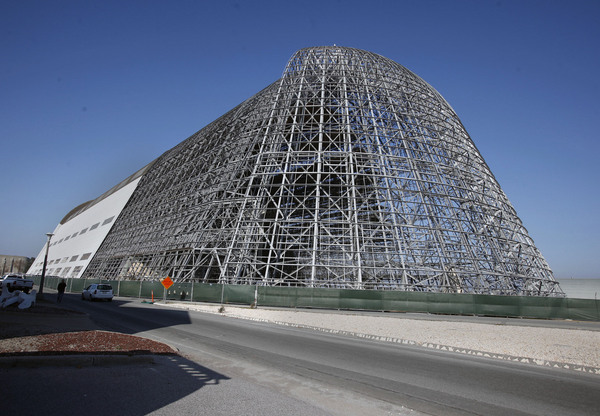 Google to restore Hangar One and operate runways at Moffett Field – MOUNTAIN VIEW — After designing driverless cars, experimenting with robots and secretly building a fleet of barges, Google is taking on a new challenge: running an airfield in the heart of Silicon Valley and restoring one of the area’s most iconic buildings, once used to house Navy blimps.
Google to restore Hangar One and operate runways at Moffett Field – MOUNTAIN VIEW — After designing driverless cars, experimenting with robots and secretly building a fleet of barges, Google is taking on a new challenge: running an airfield in the heart of Silicon Valley and restoring one of the area’s most iconic buildings, once used to house Navy blimps.
On Monday, federal officials announced they have chosen a Google subsidiary to restore the landmark Hangar One at Moffett Field and assume control of the airfield’s two runways, located just a few miles from Google’s main offices.
The move comes amid a Google expansion binge: In recent months, it’s leased several office buildings in nearby Mountain View and Palo Alto, while planning to construct another new campus from the ground up on a different portion of the Moffett property. And Google’s three senior executives also have a deal, through a separate company, to park their private jets at the federal airfield.
Google’s plans for the Moffett airfield are unclear, although the agreement could allow limited commercial development, or possibly a museum or education center at the hangar site. The company declined to comment, saying only that it wants to “preserve the heritage of Moffett Federal Airfield.”
But the news was applauded by local preservationists who have fought to save Hangar One, the massive structure visible from Highway 101 that was built to house Navy blimps after World War I. The hangar’s metal skeleton has been left uncovered since the Navy removed the skin as part of a toxic cleanup.
“That’s good news. It’s long overdue,” said Lenny Siegel, a longtime community activist who hopes the Google plan will include an aerospace museum at the site. A NASA official said her agency’s agreement with Google would allow construction of new buildings totaling up to 90,000 square feet.
Google co-founders Larry Page and Sergey Brin, who are both aviation and space enthusiasts, had previously offered to fund the renovations, which are estimated to cost $45 million or more. But they were rebuffed when U.S. officials decided to solicit competitive bids for the project.
Moffett runways are currently used for government, research and occasional private flights. Deborah Feng, associate director for NASA’s Ames Research Center, which has been operating the airfield, said Monday that the terms of a proposed lease would require Google to maintain the site’s current status as a “low-use” airfield that would be available for government flights.
Page and Brin have been operating a fleet of private jets at the airfield, under an agreement between NASA and a private aviation company that operates the planes. A spokesman for the aviation firm H211 wouldn’t rule out the possibility they might continue to use the Moffett runways, under a new lease. But he said the company is moving forward with plans to build a new private jet center for the aircraft at Mineta San Jose International Airport.
Meanwhile, the fast-growing Internet giant has a separate long-term agreement to build a new office campus on about 42 acres at Moffett, on a portion of the vast government property that is not physically connected to Hangar One or the runways. NASA and other agencies will continue to use other parts of the property.
Google abruptly halted plans for constructing nine new buildings there last summer, saying only that it wanted more time to review its designs. While officials said those plans aren’t affected by the new lease, Siegel speculated that Google might have delayed its new campus in order to coordinate with its plans for the hangar and runways.
As its online advertising business has grown, Google has expanded its range of interests far beyond its roots as a search engine. It’s experimenting with other types of new technology, from driverless cars to robots to unmanned balloons equipped with radio transmitters to deliver Internet service to remote areas. It’s recently been overhauling a pair of oceangoing barges, with plans to use them as demonstration centers for its wearable computers and other technology.
Despite many unanswered questions about Google’s plans, Siegel said he’s pleased that Google was selected to renovate Hangar One because it means the project will go forward.
Two other groups submitted proposals, according to Feng, who said one was rejected as “not responsive” and the other drew a lower score from officials who evaluated the plans. She declined to name the other groups.
Officials declined to discuss Google’s plans in detail, saying the government has only begun negotiating a formal lease with the Google subsidiary that submitted the proposal. That subsidiary, known as Planetary Ventures, is a legal entity Google uses for other projects including its planned Moffett campus.
